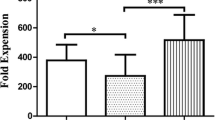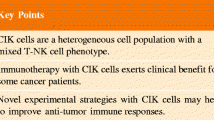Summary
Blood lymphocytes stimulated for 96 h with interleukin-2 (IL-2; 100 BRMP U/ml) (lymphokine-activated killer, LAK, cells) or granulocyte-monocyte colonystimulating-factor (GM-CSF) (10 ng/ml) became cytotoxic for Daudi cells. IL-2 was significantly more effective than GM-CSF. Only IL-2-activated cells killed SW948 (a human colorectal carcinoma cell line) while GM-CSF-stimulated cell did not. GM-CSF and IL-2 acted synergistically in a dose-dependent fashion for induction of a highly effective cytotoxic cell population (IL-2/GM-CSF cells). Il-2/GM-CSF cells were statistically significantly more effective than LAK cells in lysing Daudi cells and SW948 (P <0.05). The enhancing effect was most pronounced during the first 48–96 h of activation. Incubation periods longer than 192 h did not contribute to augmented cytotoxicity. The combination of IL-2 and GM-CSF significantly increased the number of CD25+ cells compared to IL-2 and GM-CSF alone. Furthermore, IL-2/GM-CSF cells were significantly more effective in antibody-dependent cellular cytotoxicity assays (SW948 + mAb 17-1A) than LAK cells. The chimeric mAb 17-1A was significantly more effective in tumor cell lysis than the mouse mAb. Thus, combination of various biological therapeutics might be a way to enhance their antitumoral effects.
Similar content being viewed by others
References
Asher A, Mule JJ, Reichert CM, Shiloni E, Rosenberg SA (1987) Studies on the antitumor efficacy of systemically administered recombinant tumor necrosis factor against several murine tumors in vivo. J Immunol 138: 963
Bøyum, A (1968) A one stage procedure for isolation of granolocytes and lymphocytes from human blood. Scand J Clin Lab Invest 21 [Suppl 97]: 77
Clark SC, Kamen R (1987) The human hematopoietic colony-stimulating factors. Science 236: 1229
Gasson JC, Weisbart RH, Kaufman SE, Clark SC, Hewick RM, Wong GG, Golde DW (1984) Purified human granulocyte-macrophage colony-stimulating factor: direct action on neutrophils. Science 226: 1339
Golde DW, Takaku F (1985) Hematopoietic stem cells. Dekker, New York
Grimm EA, Mazumder A, Zhang HZ, Rosenberg SA (1982) Lymphokine-activated killer cell phenomenon. Lysis of natural killer resistant fresh solid tumor cells by interleukin-2 activated autologous human peripheral blood lymphocytes. J Exp Med 155: 18823
Grabstein KH, Urdal DL, Tushinski RJ, Mochizuki DY, Price VJ, Cantrell MA, Gillis S, Conlon PJ (1986) Induction of macrophage tumoricidal activity by granulocyte-macrophage colony stimulating factor. Science 232: 506
Grimm EA (1986) Human lymphokine-activated killer cells (LAK cells) as a potential immunotherapeutic modality. Biochem Biophys Acta 865: 267
Herlyn D, Herlyn M, Steplewski Z, Koprowski H (1979) Monoclonal antibodies in cell-mediated cytotoxicity against human melanoma and colorectal carcinoma. Eur J Immunol 9: 657
Jansson C-H, Tehrani MJ, Mellstedt H, Wigzell H (1989) Anti-idiotypic monoclonal antibody to a cell chronic lymphatic leukemia. Cancer Immunol Immunother 28: 225
Klein E, Klein G, Nedkarni JS, Nedkarni JJ, Wigzell H, Clifford P (1968) Surface IgM-K specificity in on a Burkitt lymphoma cell in vivo and in derived culture lines. Cancer Res 28: 1300
Liesveld JL, Abboud CN, Looney RJ, Ryan DH, Brennan JK (1988) Expression of IgG Fc receptors in myeloid leukemic cell lines. Effect or colony-stimulating factors and cytokines. J Immunol 140: 1527
Lundgren G, Zubrowski CHF, Möller G (1968) Differential effects of human granulocytes and lymphocytes on human fibroblasts. Clin Exp Immunol 3: 817
Masucci G, Lindemalm C, Frödin J-E, Hagström B, Mellstedt H (1988) Effect of human blood mononuclear cell populations in antibody dependent cellular cytotoxicty (ADCC) using two murine (CO17-1A and Br55-2) and one chimeric (17-1A) monoclonal antibodies against a human colorectal carcinoma cell line (SW948). Hybridoma 7: 429
Masucci G, Wersäll P, Ragnhammar P, Mellstedt H (1989) GM-CSF augments the cytotoxic capacity of lymphocytes and monocytes in antibody dependent cellular cytotoxicity (ADCC). Cancer Immunol Immunother 29: 288
Masucci G, Wersäll P, Jensen N, Kierulff Nielsen H, Wigzell H, Mellstedt H (1989) Lymphokine activated killer (LAK) cells in antibody dependent cellular cytotoxicity (ADCC). A combination of potential use in tumor therapy. Hybridoma 8: 507
Mellstedt H, Frödin J-E, Ragnhammar P, Masucci G, Shetye J, Christensson B, Biberfeld P, Makower J, Pihlstedt P, Cedermark B, Harmenberg U, Wahren B, Rieger Å, Magnusson I, Nathansson J, Erwald R (1989) The clinical use of monoclonal antibodies, mAb 17-1A, in the treatment of patients with metastatic colorectal carcinoma. Med Oncol Tumor Pharmacother 6: 99
Metcalf D (1985) The granulocyte-macrophage colony-stimulating factors. Science 229: 16
Metcalf D (1986) The molecular biology and functions of granulocyte-macrophage colony stimulating factors. Blood 67: 257
Morrissey PJ, Bressler L, Charrier K, Alpert A (1988) Response of resident murine peritoneal macrophages to in vivo administration of granulocyte-macrophage colony-stimulating factor. J Immunol 140: 1910
Mule JJ, Schu S, Schwartz SL, Rosenberg SA (1984) Successful adoptive immunotherapy of established pulmonary metastases with LAK cells and recombinant IL-2. Science 225: 1487
Pross HF, Baines MG, Rubin P, Shtagge P, Patterson M (1981) Spontaneous human lymphocyte mediated cytotoxicity against tumor target cells. IX. The quantitation of natural killer cell activity. J Clin Immunol 1: 51
Reed SG, Nathan CF, Pihl DL, Rodricks P, Shanebeck K, Conlon PJ, Grubstein KH (1987) Recombinant granulocyte-macrophage colonystimulating factor activates macrophages to inhibitTrypanosoma cruzi and release hydrogen peroxidase. J Exp Med 166: 1734
Santoli D, Clark SC, Kreider BL, Maslin PA, Rovera G (1988) Amplification of IL-2-driven T cell proliferation by recombinant human IL-3 and granulocyte-macrophage colony-stimulating factor. J Immunol 141: 519
Shaw D, Khazaeli MB, Sun L, Ghrayeb J, Daddona P, McKinney S, LoBuglio A (1987) Characterization of a mouse/human chimeric monoclonal antibody (17-1A) to a colon cancer tumor-associated antigen. J Immunol 138: 4534
Sun L, Curtis P, Rakowicz-Szulczynska E, Ghrayeb J, Morrison S, Chang N, Koprowski H (1986) Chimeric antibodies with 17-1A derived variable and human constant regions. hybridoma 5 [Suppl 1]: 17
Weisbart RH, Kwan L, Golde DW, Gasson JC (1987) Human GM-CSF primes neutrophils for enhanced oxidative metabolism in response to the major physiological chemoattractants. Blood 69: 18
Wing EJ, Magee DM, Whiteside TL, Kaplan SS, Shadduck RK (1989) Recombinant human granulocyte/macrophage colony-stimulating factor enhances monocyte cytotoxicity and secretion of tumor necrosis factor α and interferon in cancer patients. Blood 73: 643
Östensen ME, Thiele DL, Lipsky PE (1989) Enhancement of human natural killer cell function by the combined effects of tumor necrosis factor α or interleukin 1 and interferon-α or interleukin-2. J Biol Response Mod 8: 53
Author information
Authors and Affiliations
Rights and permissions
About this article
Cite this article
Masucci, G., Ragnhammar, P., Wersäll, P. et al. Granulocyte-monocyte colony-stimulating-factor augments the interleukin-2-induced cytotoxic activity of human lymphocytes in the absence and presence of mouse or chimeric monoclonal antibodies (mAb 17-1A). Cancer Immunol Immunother 31, 231–235 (1990). https://doi.org/10.1007/BF01789174
Received:
Accepted:
Issue Date:
DOI: https://doi.org/10.1007/BF01789174




